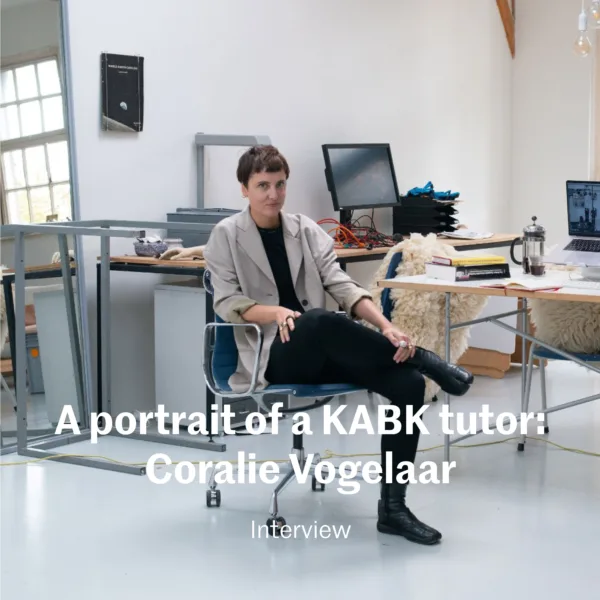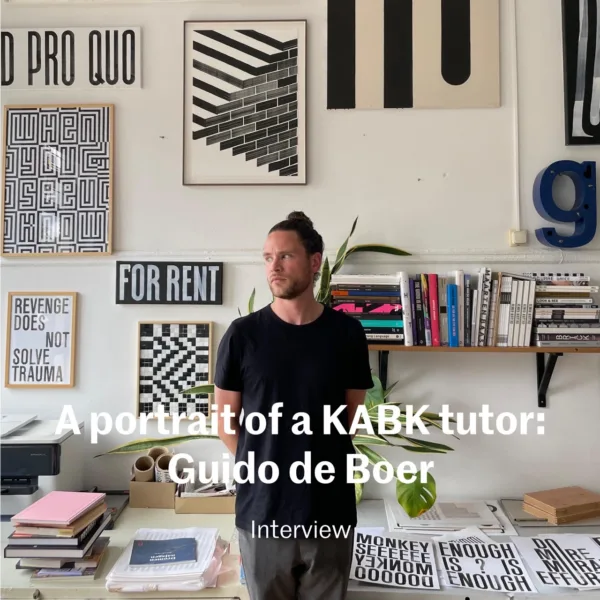When Katrin Korfmann isn’t teaching at the Bachelor Graphic Design or Master Non Linear Narrative, she spends much of her time surrounded by greenery at De 1800 Roeden, a creative space where she and other artists have their studios. Katrin’s work sits at the intersection of photography and installation. She is a visual artist, a researcher, and, of course, a teacher. Against the wall in her studio stands a colourful and dynamic piece. If you look closely, it almost seems impossible. “My work is imaginary photography; it’s my interpretation of a place. I’m fascinated by photographic time, and people are always at the heart of my work.” Her work is included in international collections and has been exhibited at the Nederlands Fotomuseum, Kunstmuseum Den Haag, and Aperture in New York, among others.
How are you doing?
I’m doing well! I just wrapped up my solo exhibition Augenblick in Amsterdam, for which I created new work. I’m also focusing on my PhD at PhDArts, and until the end of this month, my work is part of the group exhibition Doorzetters at the Noordbrabants Museum. Another exciting thing is that this month, a publication has been released by the KABK Deep Futures Research Group, which I’m a part of. It’s titled A Fray of Messays: Unraveling Research Toward the Deep Future.
You also create commissioned work, right?
Over the past few years, I’ve completed commissions for the Rijksgebouwdienst, Ministry of Finance, AMC Amsterdam, and I’m currently working on an artwork for the Radiology Department of the Leiden University Medical Center. As is often the case in my process, I’ve spent an extended period photographing a single location: the Hortus Botanicus Leiden. I return to this place every month for a year. Eventually, these pictures come together to form my interpretation of the place. I’m curious to see how the changing colours of the seasons will come through in the final result.



Is the creative process the same as when you're making work for a museum exhibition?
It’s completely different. You work with an art consultant and must consider the specific context of the location, which often functions very differently from a gallery or museum. At the Leiden University Medical Center, for example, my work will be placed in waiting rooms of the new Radiology department. I hope it will offer a moment of distraction or reflection for people who are facing a medical examination. There’s even research that shows looking at art can aid recovery, which I find a beautiful idea. In the Netherlands, hospitals have a tradition of collecting and exhibiting high-quality artworks. Since these pieces are specifically created for a location, such commissions are highly rewarding.
I also created a piece for a penitentiary. I hesitated doing the commission because I wasn’t sure how I felt about the prison system. Ultimately, I decided to proceed because I believe art can have a profoundly positive impact. The work was to be displayed in the visiting areas, with the aim of supporting difficult conversations. Art can offer a different perspective in those moments.
How do you begin a new work?
I’m interested in the temporality of things, the momentum. My fascination with photographic time plays a key role in that. I spend extended periods photographing a location, sometimes taking thousands of pictures. I then merge them into a single work; it’s my interpretation of that place. People are always present in my work; human character is essential.
What do you hope people see?
I hope people will take the time to observe the artwork, look at it, take it in, and become curious. I want them to explore further. The image slowly unfolds for those who look attentively.
Do you hope people enjoy your work?
‘Enjoy’ isn’t quite the right word. I hope it stirs something in them. Everyone will experience the work in their own way.
You’ve had major commissions and exhibitions. How did you get to that point?
Maybe partly by luck, but also through hard work. I had a strong start at the Rijksakademie, which had many international partners and excellent facilities. International opportunities followed naturally after that. I collaborated with others, built networks, and stayed active in my practice. It wasn’t always easy. You need to be flexible, especially at the beginning when you earn very little but need to stay available. I often didn’t know what the next year would look like.

What’s it like to teach at KABK?
I love being part of the academy. It’s an inspiring environment, and I enjoy connecting with students and colleagues. Students keep me sharp and challenge me. They often make me question why I do things the way I do. I teach BA Graphic Design students and MA Non Linear Narrative students. Those are two very different groups: bachelor students tend to be open and spontaneous, still figuring out which direction they want to take. Master students are more focused, inquisitive, and ask targeted questions.
How would you describe yourself as a teacher?
I started without any teaching experience and didn’t really know what I was doing. Looking back, I probably didn’t do everything right. But I’ve developed a lot since then. I try to understand what students want for themselves and encourage them to ask questions and be inquisitive. I also enjoy collaborating, for example, in the bachelor's programme, where I work with my colleague, Philosopher Maarten Cornel, on assignments that combine theory and practice.
What were you like as a student?
I studied at the Rietveld Academy (1996–1999), and to be honest, it was a difficult period for me. The programme was extremely open, supporting ego-centred artists, and I found that hard. It was also a different time: the academy had a male-dominated perspective, and there was little focus on theory. Fortunately, those things have changed for the better.
What advice would you give students?
Try to find focus and continue creating, especially when you are facing situations when things aren’t going well. Sometimes it takes time before your work is recognised, and that was true for me too. Start building your network early and collaborate. Explore the fantastic workshops we have at KABK. Ask your lecturers the things you really want to know. How would they approach a certain situation? Do you have a specific interest? Ask for tips that help to position yourself, for example, which internship might be a good fit for you. Lecturers can really help guide you in developing your own practice, after all, they’ve gone through that journey themselves.









